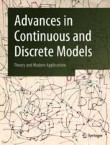
Photo from archive.org
It is known that all solutions of the difference equation Δ x ( n ) + p ( n ) x ( n − k ) = 0 , n… Click to show full abstract
It is known that all solutions of the difference equation Δ x ( n ) + p ( n ) x ( n − k ) = 0 , n ≥ 0 , $$\Delta x(n)+p(n)x(n-k)=0, \quad n\geq0, $$ where { p ( n ) } n = 0 ∞ $\{p(n)\}_{n=0}^{\infty}$ is a nonnegative sequence of reals and k is a natural number, oscillate if lim inf n → ∞ ∑ i = n − k n − 1 p ( i ) > ( k k + 1 ) k + 1 $\liminf_{n\rightarrow\infty}\sum_{i=n-k}^{n-1}p(i)> ( \frac {k}{k+1} ) ^{k+1}$ . In the case that ∑ i = n − k n − 1 p ( i ) $\sum_{i=n-k}^{n-1}p(i)$ is slowly varying at infinity, it is proved that the above result can be essentially improved by replacing the above condition with lim sup n → ∞ ∑ i = n − k n − 1 p ( i ) > ( k k + 1 ) k + 1 $\limsup_{n\rightarrow\infty}\sum_{i=n-k}^{n-1}p(i)> ( \frac{k}{k+1} ) ^{k+1}$ . An example illustrating the applicability and importance of the result is presented.
Journal Title: Advances in Difference Equations
Year Published: 2020
Link to full text (if available)
Share on Social Media: Sign Up to like & get
recommendations!